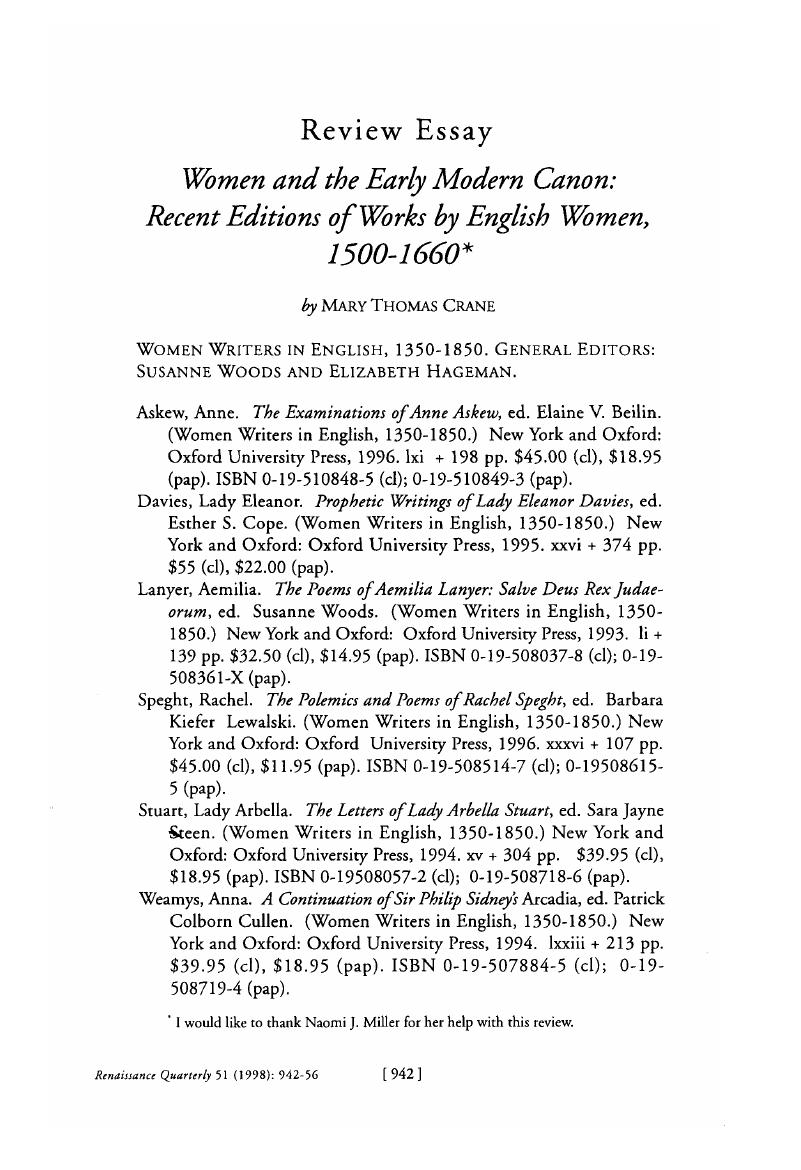Published online by Cambridge University Press: 20 November 2018

I would like to thank Naomi J. Miller for her help with this review.
1 From the General Editors’ Forward, ix-x, in each volume.
2 See the EMW website (http://chnm.gmu.edu/emw).
3 Help in teaching these authors will be readily available in 1999, when a new MLA volume, Options for Teaching Early Modern British Women Writers, ed. Margaret Hannay and Susanne Woods, will be published. For general bibliographies of work on these writers, see Elizabeth Hageman, “Recent Studies in Women Writers of Tudor England: Women Writers 1485-1603,” English Literary Renaissance 14 (1984): 409-25; and Elizabeth Hageman, “Recent Studies in Women Writers of the Seventeenth Century (1604- 1674),” English Literary Renaissance 18 (1988): 138-167.
4 Critical work on both of these writers has proliferated in recent years, so only a few central examples can be cited here. Barbara Kiefer Lewalski, Writing Women in Jacobean England (Cambridge, MA, 1993), has chapters on both Cary and Wroth. On Cary see also articles by Sandra K. Fischer, “Elizabeth Cary and Tyranny, Domestic and Religious,” in Margaret Hannay, ed., Silent But for the Word: Tudor Women as Patrons, Translators, and Writers of Religious Works (Kent, OH, 1985): 225-237; and Margaret W. Ferguson, “Running On with Almost Public Voice: The Case of ‘E.C.'” in Tradition and the Talent of Women, ed. Florence Howe (Urbana, IL, 1991): 37-67. On Lady Mary Wroth see the collection of essays edited by Naomi J. Miller and Gary Waller, Reading Mary Wroth: Representing Alternatives in Early Modern England (Knoxville, TN, 1991); as well as books by both Miller, Changing the Subject: Mary Wroth and Figurations of Gender in Early Modern England (Lexington, KY, 1996); and Waller, The Sidney Family Romance: Mary Wroth, William Herbert and the Early Modern Construction of Gender (Detroit, 1993). See also Wendy Wall, The Imprint of Gender: Authorship and Publication in the English Renaissance (Ithaca, 1993), 330-38.
5 The works of Elizabeth I herself, including speeches, poems, and letters, have also received renewed attention. A new edition of Elizabeth's writings is currently being prepared by Leah Marcus, Janel Mueller, and Mary Beth Rose, forthcoming from University of Chicago Press in 1999.
6 For a longer account of Askew and her writings, see Elaine Beilin, Redeeming Eve: Women Writers of the English Renaissance (Princeton, 1987), 29-47.
7 Karen Newman, Fashioning Femininity and English Renaissance Drama (Chicago, 1991), 143.
8 For the controversy as a whole, see Katherine Usher Henderson and Barbara F. McManus, eds., Half Humankind: Contexts and Texts of the Controversy about Women in England (.Uibznz, IL, 1985).
9 A major, two-volume critical edition of The Collected Works of Mary Sidney Herbert, Countess of Pembroke, ed. Margaret P. Hannay, Noel J. Kinnamon, and Michael G. Brennan (Oxford, 1998) is forthcoming.
10 Mariam has also been included in a new anthology, Renaissance Drama by Women: Texts and Documents, ed. S. P. Cerasano and Marion Wynne-Davies (London and New York, 1996).